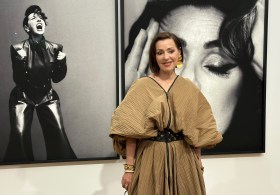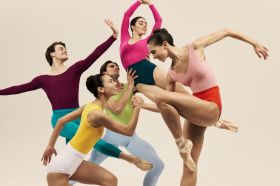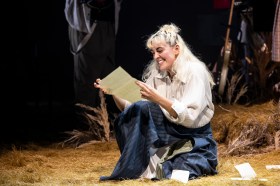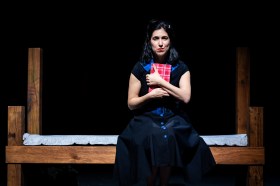The renowned American theatre critic, John Rockwell, might have written that Einstein on the Beach is ‘not for everybody’, but I am happy to report that it is definitely for me and for, at least, the majority of the audience, who rose to greet the cast with a standing ovation at the end of the show. The cynic might suggest that people were just dying to stretch their legs after sitting for four and a half hours, however, that would not explain the bravos.
Having seen Einstein on the Beach when it was performed as part of the Melbourne International Festival in 1992, I was interested to see how I would react to what had been an experience like none other at the time. Within those 21 years we have seen the Philip Glass Ensemble a couple of times, his Akhnaten as part of the 2003 Melbourne International Arts Festival and, most recently, the Live in HD Metropolitan Opera production of Satyagraha in the cinema. Even listeners to Radio National’s ‘Science Show’ are familiar with the counting excerpt from Einstein on the Beach, which introduces the program every week. Minimalist music is far from being the novelty that it used to be. Even so, this particular work still stands alone in many respects.
Apart from its sheer length, the collaboration between Glass and Robert Wilson is unusual. Wilson devised the structure and designs at the same time as Glass composed the music. Although Andrew de Groat choreographed the two ‘Field’ dances for the original 1976 production, Lucinda Childs had devised some of the movement as a performer in that production; it is her choreography that is used throughout in the current one. This time we did not see Childs herself dance, rather Caitlin Scranton, who made a compelling performer in her role in ‘Train’. If I had been asked to describe one scene from the opera from my memory of 1992, this would have been the one. The only difference seemed to be that time passed more quickly. Perhaps this is another shift in time relationships as one ages.
The other aspect that appeared different was a stronger sense of not being able to absorb as much detail as I would have expected. In fact, there was a sense of there being more of it than I had realized. One might think that with so much repetition and so much being acted out in slow motion that it would be impossible to miss any detail. But no: several times I was wondering how all of a sudden a chair was in a different place, a moon had waxed or some other such change. It is easy to immerse yourself in one sequence of action and miss out on another in a different part of the stage.
If considerable demands are made on the audience then incomparably more are made on the performers. Einstein on the Beach requires a phenomenal degree of concentration by all of them, whether on the stage or in the pit. Without complete accuracy and commitment to the moment the piece would lose its impact and much of its point. As singers shift in their counting and solfeggio syllables, the ensuing mesmerizing effect would be undermined by any faltering. Excellent memory, true pitch and amazing dexterity in articulation in hair-raisingly fast passages were all on display. There was also warmth and beauty of tone, notably in the solo sung by soprano Hai-Ting Chinn.
Stamina of all varieties was also required. Michael Riesman directed his vocal and instrumental forces mainly from an insanely busy keyboard, Andrew Sterman sustained a lengthy, frenetic saxophone solo with remarkable endurance and Antoine Silverman did the same on the violin as Einstein himself. The members of Lucinda Childs’ Dance Company must be fit enough to run a marathon, quite literally. The two ultra-aerobic dances, which would have entailed 10 or 15 minutes of energetic whirling around, often looking like hyper-charged electrons, left them dripping with perspiration and the audience gaping in astonished wonderment. Though not all possessed the bodies of classical dancers, they certainly met the demands of the choreography, and may well have been much fitter than dancers of classical ballet companies.
While it is true that the opera is abstract and much is left to the imaginative and contemplative resources of the audience, there are moments of straight narration and humour. The first ‘Trial’ scene features one of the judges recounting an amusing story about a woman in full flight indignant women’s lib mode. The same actor gently concludes the opera with a little love story. There is no Ken Russell Madame Butterfly Nagasaki atomic bomb explosion at the end. The bomb reference is more cerebral and is in some respects an anti-climax after the brilliant light display of ‘Spaceship’, which is used as the central image in publicity for the opera. Lights pulsate as performers in the square cells attend to what looks like a motherboard – a scene reminiscent of the workers in Metropolis. So many images throughout the evening are striking and resonate with contemporary cultural knowledge.
For me it was a case of ‘Einstein Revisited’ and all the richer for being so. For those who have not seen it, this is an opportunity that is unlikely to be repeated and should be embraced. The skill (and money) that is required to mount such a spectacle precludes anyone except a specialized company from doing so. The importance of just the technical expertise required for such a venture was apparent in the big line up of technicians at the front of the stage for the final curtain call.
Yes, it is long and yes, you can take up the invitation to come and go, creating your own intervals, but I believe the work is better experienced as a whole. Rather than stumbling to and fro over half a long row of legs in the dark, it is better to just sit back and immerse yourself in the opera. For those who do embrace this experience there is likely to be a shift in their perception of the nature of opera and what it can offer.
Rating: 5 stars out of 5
Einstein on the Beach
Philip Glass – Composer
Robert Wilson – Director/Set and Lighting Design
Lucinda Childs – Choreographer
State Theatre, Arts Centre Melbourne
31 July (season: 31 July – 4 August)





